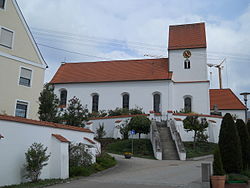
The Solnhofen Plattenkalk, or Solnhofen Limestone, is a Jurassic Konservat-Lagerstätte that preserves a rare assemblage of fossilized organisms, including highly detailed imprints of soft bodied organisms such as sea jellies. The most familiar fossils of the Solnhofen Plattenkalk include the early feathered theropod dinosaur Archaeopteryx preserved in such detail that they are among the most famous and most beautiful fossils in the world. The Solnhofen beds lie in the German state of Bavaria (Bayern), halfway between Nuremberg (Nürnberg) and Munich (München) and were originally quarried as a source of Lithographic limestone. The Jura Museum situated in Eichstätt, Germany has an extensive exhibit of Jurassic fossils from the quarries of Solnhofen and surroundings, including marine reptiles, pterosaurs, and one specimen of the early bird Archaeopteryx.

Compsognathus is a genus of small, bipedal, carnivorous theropod dinosaur. Members of its single species Compsognathus longipes could grow to around the size of a turkey. They lived about 150 million years ago, during the Tithonian age of the late Jurassic period, in what is now Europe. Paleontologists have found two well-preserved fossils, one in Germany in the 1850s and the second in France more than a century later. Today, C. longipes is the only recognized species, although the larger specimen discovered in France in the 1970s was once thought to belong to a separate species and named C. corallestris.

Herzogenbuchsee is a municipality in the Oberaargau administrative district in the canton of Bern in Switzerland.

Binn is a municipality in the district of Goms in the canton of Valais in Switzerland.
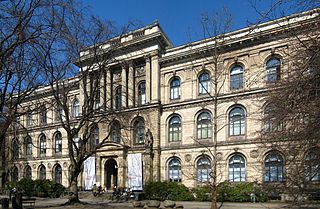
The Natural History Museum is a natural history museum located in Berlin, Germany. It exhibits a vast range of specimens from various segments of natural history and in such domain it is one of three major museums in Germany alongside Naturmuseum Senckenberg in Frankfurt and Museum Koenig in Bonn. German speakers mainly call this museum Museum für Naturkunde since this is the term that can be read in the façade's Museum. It is also called Naturkundemuseum or even Museum für Naturkunde in Berlin so that it can be distinguished from other museums in Germany also named as Museum für Naturkunde. The museum's official name changed through time. It had been originally founded in 1810 as a part of the Berlin University, which changed its name to Humboldt University of Berlin in 1949. This is why the Natural History Museum in Berlin had been known for a long part of its history as the "Humboldt Museum", but in 2009 it left the university to join the Leibniz Association. The current official name is Museum für Naturkunde – Leibniz-Institut für Evolutions- und Biodiversitätsforschung and the "Humboldt" name is no longer related to this museum. Furthermore: there is another Humboldt-Museum in Berlin in Tegel Palace dealing with brothers Wilhelm and Alexander von Humboldt.
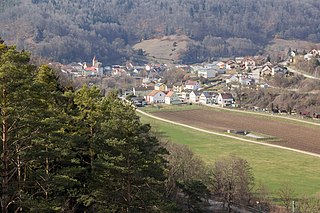
Solnhofen is a municipality in the district of Weißenburg-Gunzenhausen in the region of Middle Franconia in the Land of Bavaria in Germany. It lies within the Altmühl Valley.

Palaeopteryx is a genus of theropod dinosaur now considered a nomen dubium. It was named and misidentified by J. A. Jensen in 1981, then redescribed by Jensen and K. Padian in 1989. At that time the binomial Palaeopteryx thomsoni was deemed invalid by Jensen. The only referred specimen is a single bone fragment.

Churwalden is a municipality in the Plessur Region in the canton of Graubünden in Switzerland. On 1 January 2010 the municipalities of Malix and Parpan merged into Churwalden.

Eching is a municipality in the district of Freising, in Upper Bavaria, Germany.

Hausen bei Brugg is a municipality in the district of Brugg in canton of Aargau in Switzerland.
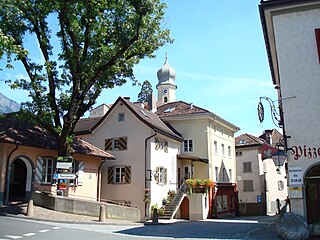
Maienfeld is a municipality in the Landquart Region in the Swiss canton of Graubünden. It is a tourist destination in the Alps, both because of the local wine and because it was the setting of the story Heidi.

The Maxberg Museum was a German museum situated in Mörnsheim in the natural park of Altmuhtal, near Solnhofen. It was founded by Alphons L. Zehntner in 1929. In 2004 was moved near to the town of Gunzenhausen, with the new name of Fossilien und Steindruck Museum.
Eduard Opitsch was a German quarry owner whose name is associated to a specimen of the prehistoric bird Archaeopteryx, the Maxberg specimen.

Ortenberg is a municipality in the town of Ortenau, Baden-Württemberg.

Quirnheim is an Ortsgemeinde – a municipality belonging to a Verbandsgemeinde, a kind of collective municipality – in the Bad Dürkheim district in Rhineland-Palatinate, Germany. It lies in the northwest of the Rhine-Neckar urban agglomeration.

Birresborn is an Ortsgemeinde – a municipality belonging to a Verbandsgemeinde, a kind of collective municipality – in the Vulkaneifel district in Rhineland-Palatinate, Germany. It belongs to the Verbandsgemeinde of Gerolstein, whose seat is in the like-named town.
Bern-Mittelland District in the Canton of Bern was created on 1 January 2010. It is part of the Bern-Mittelland administrative region, and is the only district in the region. It contains 79 municipalities with an area of 946.30 km2 (365.37 sq mi) and a population of 413,143.

Archaeopteryx fossils from the quarries of Solnhofen limestone represent the most famous and well-known fossils from this area. They are highly significant to paleontology and avian evolution in that they document the fossil record's oldest-known birds.
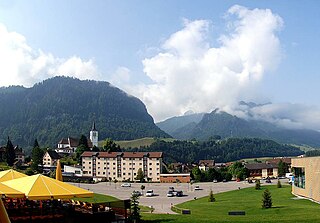
Val-de-Charmey is a municipality in the district of Gruyère in the canton of Fribourg in Switzerland. On 1 January 2014 the former municipalities of Cerniat and Charmey merged into the municipality of Val-de-Charmey.
